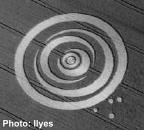| Although this very
interesting formation was cut during the first week of July it was
carefully documented photographically on June 29th by a local academic.
His photos provide evidence of a very fluid ("like water rippling
down a mountain stream") lay throughout the formation, a characteristic
which is most distinct when formations occur in grasses, but which
is also observed regularly in crop circles in other plant species.
It also seemed to me that, since these photos were
taken 3-4 weeks after the formation is known to have been
present in the field, the grasses were in remarkably good condition.
There is no evidence of them having been broken or mashed, no dead
plants -- which one would expect to have seen this long after the
circle was created if it had been mechanically flattened. Instead
the grasses appear lush and quite vibrant.
In particular, in some of the small circular areas
we can see that the grasses are often only partially flattened (again
with no evidence at all of damage), not lying flush to the ground.
And again, since the formation is known to have been present for
at least 3-4 weeks, how could these partially flattened areas fail
to reveal signs of bruising or heavier damage had they been mechanically
flattened originally? It might also be expected that these areas
would have recovered fully be standing upright again after 3-4 weeks--if
they had been created by mechanical means but not damaged during
that process. Instead, they seem to be entirely intact, as originally
formed.
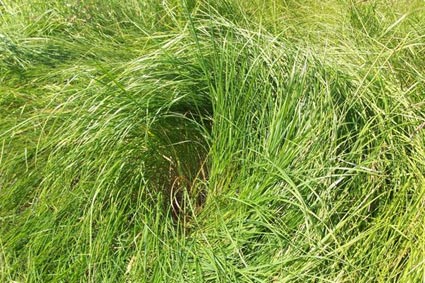 |
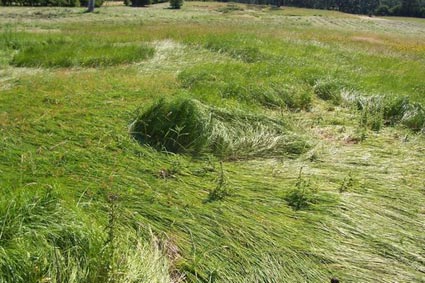 |
In the background of the photo above, behind the partially-downed
clump in the foreground, is a large circular area of standing
grasses surrounded by a flattened ring the large diameter of the
standing plants being uncommon in most crop circles. The small circular
components of the formation which are quite flat to the ground are
also interesting. In this small circle it is clear there has been
no plant damage; note also that the circle "center" is decidedly
off-center (not in the geometric center), a characteristic often
observed in many crop circles determined to be genuine through scientific
analysis of the plants and/or soils.
In the half-circle pictured above I also see evidence not only of an off-center "center" but also of a radial lay in the plants outside this particular component. A hint of the radial lay (a relatively unusual lay design) is again seen in the photo below:
There is more to be noted in this most intriguing
crop formation. The field in which the crop circle appeared is part
of a nature preseve, an area that was years ago wild prairie. According
to the two individuals with whom I've spoken (who visited the field
before the formation was cut) reintroduced clumps of once-indigenous
prairie species (photo above) could be seen scattered throughout
the formation. And as best I can tell from these anecdotal reports
(and from Michael's photographs), it appears that these reintroduced
indigenous species were not flattened it
was only the field grasses (sown by farmers once the prairie had
been settled and ploughed), which had gone down.
If this is actually what occurred in this field it
could account for the overall "patchy" appearance of the formation
in the aerial photographs. It might also have significance for those
of us trying to understand just what the crop circle phenomenon
"means." In an age when environmental pollution may have reached
critical levels (in this case perhaps calling attention to the possible
deleterious effects of pesticides and genetically-modified seed),
could this formation be an indicator (either as a spontaneously-occurring
result or even as a deliberately created message) that we should
be thinking more carefully about our food sources?
A final note. A local woman who discovered the formation while out on a walk reported elongated (lengthened) apical nodes in the flattened grasses throughout the formation. She gathered sample plants from various areas inside the circle and control plants from the edges of the field, and provided BLT with the following photos--which clearly show massive lengthening of the top nodes in the flattened grasses.
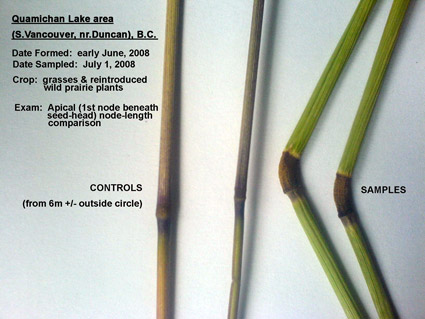
|
| Photo: BLT Research Team Inc. |
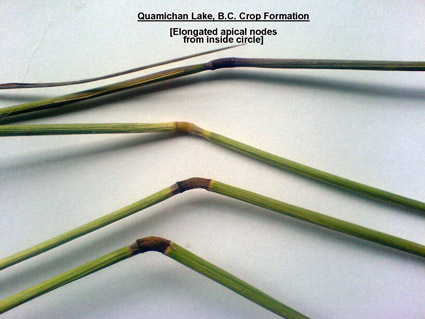
|
| Extreme apical node elongation (and moderate bending) in sample plants from within
the Quamichan Lake, B.C. formation
Photo: BLT Research Team Inc. |
Apical node elongation is the most significant
and most thoroughly documented visible plant change found to-date
in crop circle plants; see:
http://www.bltresearch.com/plantab.php
http://www.bltresearch.com/published.php
It is thought to occur as a result of microwave radiation
(one of the energies hypothesized as being part of the causative
energy system which creates crop circles) instantaneously heating
up the moisture inside the plant stems, turning it to steam. As
the steam builds up in the upper nodes (apical nodes) the tissues being
the youngest and most elastic in the plant stem stretch and elongate,
allowing the steam to dissipate. Once the steam has evaporated,
the top nodes are left permanently in this stretched, elongated
condition.
Although this was the first formation this fieldworker had personally investigated, she reported that enormously stretched nodes were immediately apparent in all areas of the formation she examined (an observation subsequently corroborated by a second, more experienced, investigator who visited the site the following week). She also observed, and photographed, a possible node change at the 2nd node beneath the seed-head, one which she thought might be the beginning of, or some version of, an expulsion cavity. [Expulsion cavities are holes literally blown out at the nodes, usually in the lower nodes of the plant stem--caused also by microwaves heating up the moisture inside those nodes. As moisture in these lower nodes turns to steam is cannot escape by stretching the much tougher fibers lower down the plant stem--exploding the external fibers instead.] Expulsion cavities do not occur in all formations exposed to this microwave heating, due (we think) to varying intensity levels of the microwaves themselves from event to event and also to varying amounts of moisture inside the plant stems at any given time.
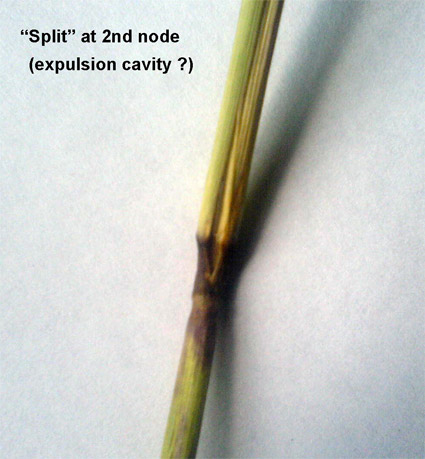
|
| Possible steam effect at 2nd node beneath seed-head in crop circle plant stem
Photo: BLT Research Team Inc. |
We do not have the data to know for certain whether
this particular node change is related to exposure of these plants
to the energy system responsible for creating this crop formation
or not. The darkened area around the node is an indication that
a common opportunistic fungus called ustilago
(the spores of which attach themselves to exudate from inside the
plant stem and then turn the tissue dark brown or black as they
multiply) is present which suggests that there is at least a very
small hole through the external fibers of the plant stem into the
moist interior. But in this case we do not have enough evidence
to be certain.
Overall, a very interesting and complex crop formation.
I wish we had known of its existence in time to have carried out
a more intensive evaluation, but am grateful to everyone involved
in helping us gather the information we do now have.
|

